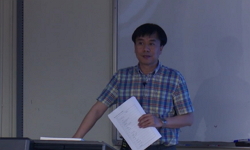In vitro zoysia grass regeneration has several difficulties. We report here a simple and reproducible protocol by using seed explants. We selected the yellow colored calli for plant regeneration, as other types of calli were found to be poor in their ...
http://chineseinput.net/에서 pinyin(병음)방식으로 중국어를 변환할 수 있습니다.
변환된 중국어를 복사하여 사용하시면 됩니다.
- 中文 을 입력하시려면 zhongwen을 입력하시고 space를누르시면됩니다.
- 北京 을 입력하시려면 beijing을 입력하시고 space를 누르시면 됩니다.
https://www.riss.kr/link?id=A82355411
-
저자
In-Ja Song ; Markkandan Ganesan (제주대학교) ; Eun Jeong Kang ; Hyeon-Jin Sun ; Tae-Woong Bae ; Pyung-Ok Lim ; Pill-Soon Song ; Hyo-Yeon Lee
- 발행기관
- 학술지명
- 권호사항
-
발행연도
2010
-
작성언어
English
-
주제어
2 ; 4-D ; 2iP ; hardening ; regeneration ; yellow callus ; zoysiagrass
-
KDC
525
-
등재정보
SCIE,SCOPUS,KCI등재
-
자료형태
학술저널
- 발행기관 URL
-
수록면
222-225(4쪽)
- 제공처
- 소장기관
-
0
상세조회 -
0
다운로드
부가정보
다국어 초록 (Multilingual Abstract)
In vitro zoysia grass regeneration has several difficulties. We report here a simple and reproducible protocol by using seed explants. We selected the yellow colored calli for plant regeneration, as other types of calli were found to be poor in their capacity for callus multiplication and/or shoot induction. However, both previous reports and the present study encountered difficulties in plant regeneration with the yellow type calli during their growth and shoot multiplication. Some of the major difficulties included the formation of different types of calli from a single explant that appeared to be of a regenerable type of calli (yellow compact, yellowish white compact and white friable), abnormal growth induction from the callus (hairy root formation, browning, and formation white compact structures resembling somatic embryos), greening of callus without further shoot formation, micro-shoot formation without further growth and conversion of micro-shoots into callus. To circumvent these difficulties, we established an improved protocol for zoysia regeneration. Results showed that 2iP (1.0 ㎎ · ℓ?¹) and GA3 (1.0 ㎎ · ℓ?¹) not only enhanced shoot induction percentage, but also increased the number of shoots from the callus cultures when compared with BAP treatments. During shoot initiation, the difficulties mentioned above were substantially alleviated. Both shoot induction and simultaneous shoot elongation were satisfactorily achieved on the same medium. The elongated shoots were rooted on half MS media. The simple but reproducible regeneration protocol established in this study may facilitate the work on transformation and genetic improvements for Zoysia japonica Steud. and other closely related grass species.
목차 (Table of Contents)
- Abstract
- Introduction
- Materials and Methods
- Results and Discussion
- Acknowledgement
- Abstract
- Introduction
- Materials and Methods
- Results and Discussion
- Acknowledgement
- Literature Cited
동일학술지(권/호) 다른 논문
-
- 한국원예학회
- Hai Thi Hong Truong
- 2010
- SCIE,SCOPUS,KCI등재
-
- 한국원예학회
- Camila Pegoraro
- 2010
- SCIE,SCOPUS,KCI등재
-
- 한국원예학회
- Md. Humayun Kabir Shiragi
- 2010
- SCIE,SCOPUS,KCI등재
-
- 한국원예학회
- Satisha Jogaiah
- 2010
- SCIE,SCOPUS,KCI등재







 ScienceON
ScienceON DBpia
DBpia







